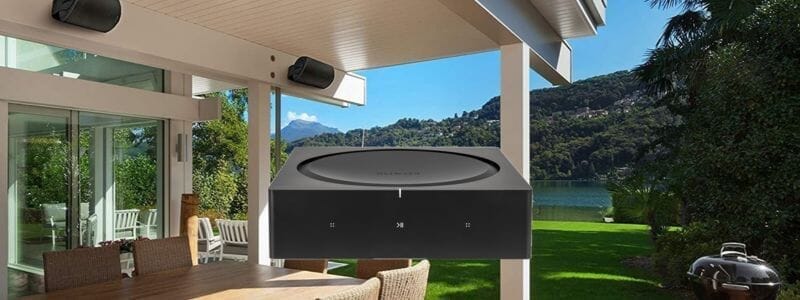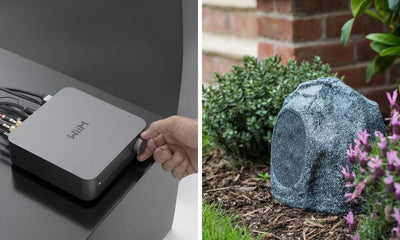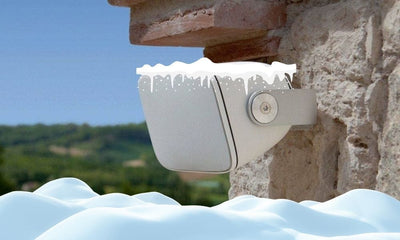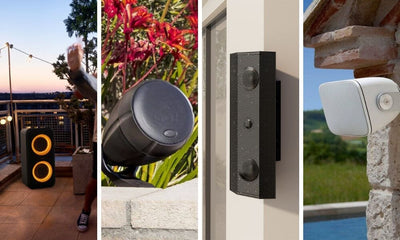In This Article: We'll explore the best amplifiers to use with your outdoor speakers. For example...
- The best ways to control the amplifier
- Amplifier power requirements for outdoor speakers
- Managing outdoor audio zones
- Getting adequate outdoor speaker coverage
... I'll also include links to recommended products and more useful content to help you plan your outdoor speaker system.
Outdoor speakers can transform your garden into an oasis of entertainment allowing you to enjoy your favourite music while relaxing or hosting gatherings.
However, to achieve optimal sound quality and performance it is crucial to pair your outdoor speakers with the right amplifier for the job.
In this blog post we'll delve into the key factors you should consider when choosing an amplifier for outdoor speakers ensuring that you make an informed decision that suits your specific needs.

Connectivity
It is important to first consider how you want to play your music, and I feel this is the starting block for your amplifier decision.
With most amplifiers you can’t leave them or place them outside, they aren’t weather-proof, so you’ll need to place it in a dry, watertight location such as a garage, garden building or in the house.
But how will you then control it?
Bluetooth
One of the most popular connections is Bluetooth.
You can easily pair a smartphone, tablet or computer and play your music.
This works great for most speaker systems but bear in mind that Bluetooth has a maximum range of around 8-10 metres on a good day. That’s before you take into account walls, bifold doors etc.
So if you’re going for a Bluetooth amplifier, which is a very popular choice, make sure that you can place the amplifier nearby the listening area.
Pro Tip: With some of our smaller basic Bluetooth amplifiers such as the SimplyBT systems you can install them in a plastic waterproof electrical enclosure outdoors to keep them near the listening location.
We recommend wall-mounting the enclosure, ideal for mounting to a garden structure such as a pergola or near a decking area.
Note that with Bluetooth the music will interrupt if you;
- Go out of range
- You get a text message / email
- You get a phone call
Whilst not a major issue, this can be annoying - especially for your BBQ guests whilst you disappear on a phone call!
You can get around most Bluetooth issues if you have an iPad or spare device that you use to stream the music from - no phone calls or messages and you can keep it nearer the amplifier if range is an issue.

Wi-Fi
A WiFi amplifier is the ultimate way to control your garden speakers for multiple reasons;
-
No Range Issues: The amplifier connects to your WiFi network and your phone controls the music via the amplifier, as long as your amplifier is on the WiFi network your music will keep playing - even if you pop to the shops with your phone to get some more beers!
-
Multiroom Grouping: Another benefit to WiFi is that you can usually group multiple zones together. Imagine having the kitchen and the garden playing in perfect sync, all controlled from your smartphone.
-
More Streaming Choices: With a WiFi amplifier you can easily stream Spotify Connect, internet radio, Deezer and many more internet music sources.
- Easier To Control: Ever been playing music at a family BBQ and something really inappropriate from Rage Against The Machine comes on? With WiFi you can easily skip the track from the app, from your smartphone or by shouting at Alexa. Beep You I won’t do what you tell me? Yes you will Alexa.
The downside? Well only one really, it’ll cost you more.
You do also need good WiFi coverage, especially for the amplifier itself. If your WiFi network is patchy at best then consider upgrading it to a mesh network.
WiFi issues are becoming less common since WiFi technology has come a long way over the last few years in particular. Internet providers' standard equipment is becoming more and more capable and mesh networks are cost-effective and easy to install.
You can find a useful guide about mesh WiFi networks from TP-Link.
The ultimate outdoor speaker amplifier really is the Sonos AMP - it’s powerful with 125W per channel and has a whole host of connectivity options including Amazon Alexa & Google - you can also run up to three pairs of Sonos outdoor speakers directly from it.
Overall you’ll get a much better, easier to use system and may find that it gets used far more frequently than alternative methods - which increases the lifetime value of your outdoor speaker system.
Manual
Sometimes it is good to keep it simple.
If you’re happy to go to the amplifier, turn it on, start your music playing and leave it doing its thing then you have a lot more options.
Maybe you have an old stereo HiFi amplifier that you can re-purpose?
Or maybe you have an AV receiver in a nearby home-cinema room that you can utilise the Zone 2 for a pair of speakers on the patio.
You can easily add WiFi streaming capabilities to it with a WiiM Mini.
We often recommend the Adastra range of commercial amplifiers - the Adastra A Series Power Amplifiers.
These are high-power amplifiers with multiple zones that let you easily create multi zone garden speaker systems without spending a fortune.
Pair them with WM Multiroom streamers and you have a pretty amazing system!

Power
One of the primary considerations when selecting an amplifier for outdoor speakers is the power output.
Outdoor speakers will typically require more power than an indoor speaker.
Adequate power ensures that your speakers can deliver high-quality sound especially in outdoor environments where sound dispersion can be challenging.
Check the power requirements of your speakers and choose an amplifier that can provide sufficient power to match their needs.
It is important to consider your overall goal here, if you’re just adding speakers to a garden pergola or seating area only then you can get away with a lower power amplifier.
Are you planning to add an outdoor subwoofer?
If so then you’ll need to be able to adequately power it.
Outdoor subwoofers are commonly low-impedance 8 ohm and a 50-100W amplifier should be able to run a pair of speakers + the subwoofer directly.
But for larger systems or when you want optimal performance you should consider either a separate subwoofer amplifier or a larger overall amplifier.
Further Reading: Outdoor Speaker Wiring Guide: How To Plan & Cable Outdoor Speakers

Coverage
Power isn’t everything if you don’t have good coverage.
With outdoor speakers you will find that the mid range and the top end will fade off quickly as you move further away from the speaker itself.
Bass travels a lot further, which is why it’s important to choose a larger speaker or use a separate subwoofer in bigger installations.
Multiple Zones
We always suggest that you plan your coverage, choose your “zones” and don’t try to cover everything with one pair of speakers.
What is a zone?
An audio zone would typically relate to "a room that you want to listen to music in".
With multiroom audio you'd normally have one amplifier per zone, and the ability to group multiple zones together.
This works great for a kitchen and a living space for instance. You may want to use the rooms separately with different music playing, or group them both together to enjoy the same song across both rooms.
But with gardens its often one overal "zone" with different areas, this gives us a bit more flexibility and you don't always need to go for multiple amplifiers.
There are three ways you can manage your zones;
- Multiple Speakers On One Amplifier: You can connect up to two pairs of speakers to most amplifiers directly. With the Sonos AMP you can connect three pairs of Sonos outdoor speakers.
Best for small to mid sized zones. - Multiple Amplifiers: If you want to have different music in different areas, or want to adjust the volume in each area then you'll need to go for a multizone system with 2 or more WiFi amplifiers.
For example if you have two Sonos AMP's powering two zones you can listen in one area at a time, both areas in sync with different volume levels or, if your garden is big enough, two different music sources at the same time.
Best for larger zones and larger gardens with different spaces that can be used separately as well as together. - Speaker Switches: This is a bit of a hybrid to the above two options. You only need one amplifier and you can feed up to four pairs of speakers. Each pair can individually be turned on / off for some basic zonal controls - but the volume is the same throughout.You do have some limitations, for example you can't adjust the volume in each area independently and every pair you turn on will lower the overall power from the amplifier, but it's a great option for mid sized gardens with distinct areas.
Getting the above right means that you can keep the overall volume lower (less chance of annoying neighbours) and everyone in the garden gets a better experience.
Most of our customers' gardens are between two and six speakers making it easy to plan as you can run four speakers from most of our amplifiers - or use a speaker selector switch for up to eight speakers in total.
Multi Channel Amplifiers
If you have a really big garden speaker project then you will likely benefit from multi channel amplifiers.
These have much more power as each pair of speakers can be driven from its own amplifier.
For example the Monitor Audio IA60-12 has six separate amplifiers in one unit.
Each amplifier can run a pair of speakers and you can configure them to all play back in perfect sync.
This allows you to do much larger installations with multiple stereo speakers and even a subwoofer.
Final Thoughts
Choosing the right amplifier for your outdoor speakers is crucial to achieving exceptional sound quality and ensuring their longevity in outdoor environments.
Remember to consider factors such as power compatibility, weather resistance, connectivity options, amplifier features and size.
Don’t forget that you can upgrade the amplifier in the future if needed, so if you want to spend a bit more of your budget on the speakers initially then upgrade the amplifier in future that’s fine.
We’ve created numerous outdoor speaker system bundles to make your life easier and if you need any further help please feel free to contact us via the audio consultation for more bespoke advice.





